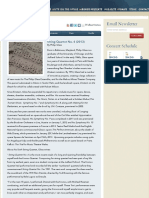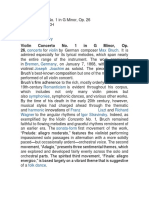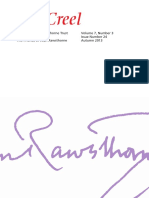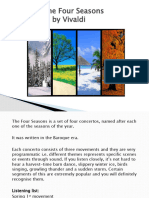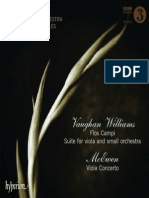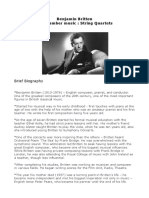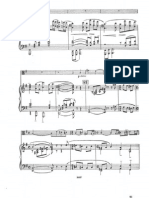0 ratings0% found this document useful (0 votes)
532 viewsHindemith 1939 Viola Sonata Paper
Hindemith 1939 Viola Sonata Paper
Uploaded by
Greg LuceThis document provides biographical context about composer Paul Hindemith and his 1939 Sonata for Viola and Piano. It discusses Hindemith's complicated relationship with the Nazi government in Germany, his growing admiration for the United States after multiple visits, and how he composed the 1939 sonata during his third and longest concert tour in the US before becoming an American citizen in 1940 to escape Nazi rule in Germany. The sonata premiered only ten days after its completion with Hindemith on viola.
Copyright:
© All Rights Reserved
Available Formats
Download as DOCX, PDF, TXT or read online from Scribd
Hindemith 1939 Viola Sonata Paper
Hindemith 1939 Viola Sonata Paper
Uploaded by
Greg Luce0 ratings0% found this document useful (0 votes)
532 views23 pagesThis document provides biographical context about composer Paul Hindemith and his 1939 Sonata for Viola and Piano. It discusses Hindemith's complicated relationship with the Nazi government in Germany, his growing admiration for the United States after multiple visits, and how he composed the 1939 sonata during his third and longest concert tour in the US before becoming an American citizen in 1940 to escape Nazi rule in Germany. The sonata premiered only ten days after its completion with Hindemith on viola.
Original Description:
in fulfillment for the DMA program at UMD
Original Title
Hindemith 1939 Viola Sonata paper
Copyright
© © All Rights Reserved
Available Formats
DOCX, PDF, TXT or read online from Scribd
Share this document
Did you find this document useful?
Is this content inappropriate?
This document provides biographical context about composer Paul Hindemith and his 1939 Sonata for Viola and Piano. It discusses Hindemith's complicated relationship with the Nazi government in Germany, his growing admiration for the United States after multiple visits, and how he composed the 1939 sonata during his third and longest concert tour in the US before becoming an American citizen in 1940 to escape Nazi rule in Germany. The sonata premiered only ten days after its completion with Hindemith on viola.
Copyright:
© All Rights Reserved
Available Formats
Download as DOCX, PDF, TXT or read online from Scribd
Download as docx, pdf, or txt
0 ratings0% found this document useful (0 votes)
532 views23 pagesHindemith 1939 Viola Sonata Paper
Hindemith 1939 Viola Sonata Paper
Uploaded by
Greg LuceThis document provides biographical context about composer Paul Hindemith and his 1939 Sonata for Viola and Piano. It discusses Hindemith's complicated relationship with the Nazi government in Germany, his growing admiration for the United States after multiple visits, and how he composed the 1939 sonata during his third and longest concert tour in the US before becoming an American citizen in 1940 to escape Nazi rule in Germany. The sonata premiered only ten days after its completion with Hindemith on viola.
Copyright:
© All Rights Reserved
Available Formats
Download as DOCX, PDF, TXT or read online from Scribd
Download as docx, pdf, or txt
You are on page 1of 23
1
Paul Hindemiths 1939 Sonata for Viola and Piano
12/10/2012
Gregory Luce
This paper will consist of selected biographical tidbits of Paul Hindemiths life, focusing
finally on the historical significance of his final sonata for viola and piano, the only one written
without opus number, which was written in late 1938 and early 1939. This sonata is simply yet
formally known as the Hindemith 1939 Sonata for Viola and Piano. His final sonata for solo
viola, written in 1937, also bears no opus number. Given that all of his other sonatas for solo
viola or viola and piano bear opus numbers, we can surmise that in willfully removing this key
descriptor from his title page he acknowledges in part that he is not writing just another sonata,
but perhaps that he has now written his most authoritative works. The Viola Sonata of 1939
bears more historical weight than Viola Sonata, op. 50. He has framed this particular piece not
in terms of his personal history, but in a much more monumental sense of history.
Some historians and musicologists have labeled Hindemith as a prosaic, utilitarian sort of
composer. In particular the admission of the term Gebrauchtsmusik (this term defines music
written for some utilitarian purpose or in this case perceived as propaganda) in scholastic
publications did not help the case of Hindemith as an art composer. Hindemith as a personality
could not possibly be more different than the image which some historians have constructed for
him! In observing his writings and correspondence we can see that underlying this restrictive,
ill-informed image is a quirky, poetic personality with a great appetite for humor, wit, and
charm.
2
Hindemith was born in 1895 and in my mind his life can be divided into three portions:
first as a German citizen living in Europe until 1940, then living in the US as an American
citizen until 1953, and finally as an American expatriate living in Zurich from 1953 until his
death in 1963. While these dates dont divide equally into three thirds of his life, they more
importantly show distinct periods of his compositional moods being affected by his life
circumstances. I would like to focus, of course, on the portion of his life leading up to the
composition of his 1939 sonata to give a bit of historical context to this work.
It is important to make a brief acknowledgement of the different musical styles which
influenced Hindemith. He throughout his life loved the music of Bach and that of the folk
German Renaissance in particular. While his music of course has a very different sound from
these two influences in particular for reasons including a more adventurous harmonic palette, a
larger variety of phrase lengths, and a more fluid impression of tonality, these influences can
nonetheless be seen strongly in his music. Several ways in which his music shows these
influences are in the inclusion of a tonal center, the acknowledgement of traditional structural
materials from (for example) the rondo and sonata forms, and the ever-important emphasis that
exists on the downbeat in his music.
Hindemiths first full-time professional musical engagement was as a violinist in Heiden,
Switzerland in an orchestra formed to entertain vacationers starting in 1913. Before this he had
been studying violin since a very young age at the behest of his parents and eventually formed a
string quartet, the Amar Quartet, in 1921 which was rather active until it disbanded in 1929. It
was for the purposes of playing in this quartet that I believe he truly learned to play the viola at a
high level. This quartet has actually recorded several works on Polydor Records: namely
Beethovens Serioso, Mozart Quartet K. 428 in E Flat, and Bartoks
second quartet. At this
3
time Hindemith had composed and was composing a small variety of works, from solo sonatas
for several instruments all the way up to fully staged operas. The same year this quartet
disbanded in 1929, Hindemith performed the world premiere of the Walton Concerto after Lionel
Tertis, for whom it was written, decided not to play it. (Kohl 2012) I believe it was from this
point onwards that his musical career became one of not just national but international
recognition, paving the way for him to become a legendary performer, lecturer, and of course
composer of music.
As with many composers during this period of German history, Hindemith had a very
difficult and complicated relationship with the Nazi government in his early life. In fact, by
1934 the extremist portion of the Nazi party (in this case in a speech by Joseph Goebbels) had
condemned him as a degenerate, atonal noisemaker. I will explore the validity of this claim
later; however, the more reasonable side of the same party also saw great promise in his music,
as it was quite clear he often drew inspiration from the folk idiom. The folk idiom was viewed
positively in music by the Nazi party as it clearly celebrates (in this case) German heritage with
no strings attached. These conflicting views of Hindemiths music in the end cancelled each
other out, and no actions largely positive or negative took place against or for Hindemith during
his time in Germany. In early 1940, just before the true global outbreak of the Second World
War in May of that year (Siebert 2012), Hindemith and his wife were nationalized as American
citizens and moved to New Haven, Connecticut. If they hadnt taken this action, it is quite
possible that Hindemiths inspirations and immense talents would have become no more than
another under-developed tool in the hands of the defunct Nazi government.
Before his nationalization as an American citizen, Hindemith became enamored with the
United States over a period of three concert and educational tours from 1937 to 1939. The first of
4
these engagements came by the invitation of Oliver Strunk in 1936, the chief of the musical
division at the Library of Congress. He insisted that should Hindemith be able to attend, they
would be able to put together an all-Hindemith chamber concert and feature Hindemith himself
as the soloist of the American premiere of Der Schwanendreher, Hindemiths viola concerto of
1935, in a separate event. Given the high profile of this event, Hindemith was delighted to
accept the engagement. Shortly after he sent his acceptance off to Mr. Strunk, Strunk responded
with insistence that he was sure that Klemperer, Koussevitsky, and Stokowski would
undoubtedly seek engagements with him as well. Hindemith was perhaps keenly aware of the
mounting tensions between the US and the Nazi party in the late 1930s and responded rather
sheepishly, I think it would be better if you not push too hard. (Noss 1989, 13)
Perhaps it was the entire week spent aboard the S.S. Deutschland, but the effect of seeing
NYC for the first time inspired in the anxious Hindemith a mixture of positive feelings. In a
letter to his wife he said the following about seeing New York Citys skyline loom in the
distance: One has seen it a thousand times in films and photographs but it is too fantastic to
describe. The skyscrapers of Manhattan are absolutely wild, going beyond anything you ever
imagined. It looks like a completely berserk castle, with countless sharp and narrow turrets
trying to outdo each other. It looks like a fairyland, for it is so improbable that man could have
built anything like this. Surprisingly, it is not over-powering, as I expected it to be. On the
contrary, it makes a light and even joyful impression. (Hindemith, Letter: Hindemith to Gertrud
Hindemith 1939, 2) Keep in mind this image of a composer observing a mind-boggling skyline,
yet the final impression for him was not one of insignificance or nervousness, but of a fanciful,
fearless joy. We will make use of it later as we observe the 1939 Sonata.
5
Hindemith shortly went from being treated as an atonal noisemaker to being pampered
in the United States as a world-class musician. Apparently a few days before his arrival into
New York City his ship received what he called a magical note from the Library of Congress
which enabled him to pass through customs hassle free, delighting him a great deal as one can
imagine. (Noss 1989, 17)
It is following a successful and apparently very tiring concert tour in the United States
that Hindemith made his first mention of the possibility of settling in this country. In a letter
made out to Mrs. Coolidge he mentioned the possibility of immigrating, given the favorable
reaction he had received to his music. Hindemith did not say at the time that this was desirable
to him; he in fact mentioned the impracticalities of such a move. His mind would change on this
subject very soon but in either case, the idea was certainly there.
The next concert tour of the United States was forty-four days long, and only in the end
amounted to eleven concerts. While Hindemith was somewhat disappointed by this, the concerts
went well and were well received. For purposes of brevity little about this tour needs to be
mentioned, except that Hindemith brought a viola damore with him on this trip and says that it
was checked by four officials, one after the other. I doubt whether even the sinners on Judgment
Day will be so rigorously examined. (Noss 1989, 32)
It is during his third and longest concert tour in the United States (eleven weeks total,
more than the other two visits combined) that Hindemith composed his final sonata for viola and
piano. This piece premiered with the composer playing the viola and Jesus Maria Sanroma at the
piano on April 23
rd
, 1939. The work was completed only ten days before and in a letter to his
wife states of the event that The hall was filled with many young peopleThe playing was very
6
good throughout and the concert was a great success. The program was nicely plannedOne of
the radio critics gave it a rating of four stars, like cognac. This rarely happens in modern
music. (Noss 1989, 54) Other works on the program were the Woodwind Quintet of 1922,
performed by musicians from the Boston Symphony, Five Songs on Old Texts, Clarinet Quartet
of 1938, and Sonata for Piano Four Hands. Most of it seems to have been received quite well
except for the Clarinet Quartet, which Hindemith said made the audience seem a little tired.
(Noss 1989, 54)
Immediately following his third and most successful concert tour to the US, Hindemith
applied for US citizenship and accepted a teaching position at Yale University which he held for
thirteen years. Long gone was the self-deprecating and overly critical young Hindemith,
struggling to find his voice in the Nazi constraints of Germany in the early twentieth century.
Now Hindemith had the following sort of not very modest claims of his work:
I played flawlessly in the two concerts. (Skelton, Selected Letters of Paul Hindemith 1995,
135)
The violin sonata lies complete in the drawer, the final movement is a triple fugue that will
make a connoisseurs heart jump for joy. (Skelton 1995, 136)
Someone greeted me the other day as the greatest living composerAnd how! (Skelton 1995,
155)
While many of these statements were given with the lightest of heart, in perusing his
letters this is the sort of writing that you simply dont see before his collaborations in America
began. America had given him a great deal of confidence with its possibilities and freedoms, and
7
he intended to use them to their fullest. Hindemith referred humorously to America in a letter to
his good friend Willy Strecker in February of 1938 as the land of limited impossibilities.
In his move to the United States Hindemith was coming from a short-term residence in
rural Turkey to the metropolitan New York area. In making this move Hindemith also became
more cosmopolitan in terms of his compositional tendencies. Before moving to the US
Hindemith composed a rather small variety of compositions - his writing was largely for the
symphony or for strings. After his physical move to a more bustling area, his composition
bustled as well; after this he composed sonatas for clarinet, harp, horn, alto horn (or saxophone),
trumpet, English horn, tuba, double bass, trombone, a dozen concerti for mixed instrumentation,
operasthe list continues.
As we have reached the historical point of Hindemiths composition of this work I will
now move from biographical concerns to the considerations of Hindemiths music, its
construction, and his opinions of the philosophy of composition, which is imperative to any sort
of understanding of his music.
In 1942 an English translation of a book by Hindemith entitled The Craft of Musical
Composition appeared for sale in New York City. This books purpose is to create a good base
for compositional techniques to replace older methods, or at least to supplement them. It is an
incredible resource for not just those analyzing the music of Hindemith, but also for those
desiring to broaden their understanding of music, especially in terms of tonality. I would like to
explore some of Hindemiths most important statements in this book. Here is a segment from his
introductory chapter. The road from the head to the hand is a long one while one is still
conscious of it. The man who does not so control his hand as to maintain it in unbroken contact
8
with his thought does not know what composition is. The goal must always be such a mastery
that technique does not obtrude itself, and a free path is prepared for thought and feeling. The
man to whom the tones are a necessary evil with which he must wrestle; or who sees in them a
perfectly tractable medium in which he can express himself without any restraint; or who climbs
up on them as a ladder, or wallows in them as in a bog - such a man is simply adding to the
infinity of pieces that are written every year without moving a human ear or spirit. (Hindemith,
The Craft of Musical Composition 1945, 12)
The first step according to Hindemith in understanding his view of composition is a
metaphysical examination of intervals and sound. The journey of his book begins with a
discussion of the overtone as a tool for overcoming the obstinacy of the tones themselves.
(Hindemith, The Craft of Musical Composition 1945, 16) Hindemith then communicates his
beliefs on the true tonal scale, and once he has made some slight alterations based on his current
world of tempered intonation, arrives at the chromatic scale as the greatest natural equalizer of
pitches. In his mind, the fluidity of pitch relationships in the chromatic scale completely
overrides the necessities of minor and major in music. We are no longer the prisoners of the
key. Rather, we now have a free hand to give tonal relationships whatever aspect we deem
fitting. (Hindemith, The Craft of Musical Composition 1945)
In the traditional diatonic scale, he explains, some pitches are completely subservient to
the more important tonic and dominant scale degrees. He then creates a beautiful image of the
central tone of a piece being likened to the sun of a harmonic planetary system, with the other
pitches revolving around it. Notes to him relate to the tonic key in terms of their chromatic
distance from it, not in terms of their traditional melodic or harmonic value. Music, as long as
it exists, will always take its departure from the major triad and return to it. The musician cannot
9
escape it any more than the painter his three primary colors, or the architect his three dimensions
It is the force of gravity, and no will of ours, that makes us adjust ourselves horizontally and
vertically. (Skelton, Paul Hindemith: The Man Behind the Music 1975, 147)
In observing the music of Hindemith to see how it relates to this tonal yet un-diatonic
system which he puts forward, Geoffrey Skelton, author of Paul Hindemith: The Man behind the
Music, believes that Hindemiths music conforms most closely to this triadic behavior in the
periods surrounding his tours to America and of his naturalization there, from 1937-1941 the
period directly surrounding the 1939 Sonata. Skelton claims after noting that it was immediately
following the commitment of Hindemiths Craft of Musical Composition to paper and that
His later divergences were the result of second thoughts and new discoveries. (Skelton, Paul
Hindemith: The Man Behind the Music 1975, 152-3)
Hindemith spends thirty-five pages towards the beginning of his book expounding upon
the acoustic phenomena of the chromatic scale. Given his earlier poetic language about the
importance of a home key, Hindemiths exploration of the merits of the chromatic scale is hardly
surprising, as it is undoubtedly the most clear-cut way for us to observe the distance to any scale
degree from that of its progenitor. In the end for Hindemith it is often the smallest melodic
changes, rather than the largest (such as the use of a huge leap in the human voice) that brings
about the most poignant expression.
Let us now move onto the topic of this piece and its merits more specifically. In my
discussions with Professor Murdock we have come to an agreement that there are several things
in particular which should lead a listener to an immediate and fulfilling appreciation of this
piece. The first is the consideration of Hindemiths use of melody and how it relates to rhythm.
10
Hindemiths rhythmic language often borrows from the folk idiom. To Hindemith, it
seems, there is a great vein of rhythmic expression to be tapped in a melody. Observing the
complexity of some of his melodies reveals not a single inconsiderate use of rhythm. A strong
example of this is at the beginning of the fourth movement of this piece. Here you can observe
several interesting compositional elements which lend to this music a great effect. The first is
the rhythmic interplay between the viola and piano. Sometimes the rhythms of the two are in
complete agreement (such as in the first two bars) and at other times there is some back and forth
writing which is very contrapuntal in nature (such as in bars 3-5).
Secondly, notice the shift in character that takes place in the melody as it gets away from
the dotted rhythm idea of the first five bars. This happens as the line rises in bar 6.
The third observation is to notice the way (starting in bar 8) that Hindemith has a very
facile talent for traversing a small distance in terms of key relationships. Heretofore this required
a great deal of what I would call harmonic explanation in the music of his predecessors. You can
also notice just in the final two bars an easy motion between the G flat downbeat of bar 14 to the
final downbeat, which returns to the same F that begins the movement.
11
12
It is because of Hindemiths adherence to a tonal center that some people label his music
as being neo-classical. However, what Hindemith borrows is not the sound of the classical
period as Stravinsky and Schnittke do, for instance, but the symmetry and forms of the ages
before him. The final movement of this piece is a theme with two variations. At the beginning
of the first variation one sees the same elements at play as were in the theme, but in a remarkably
different character. Hindemith shows his versatility by using the same elements to create a
moment of incredible whimsy, elegance, and playfulness.
In observing the first fifteen bars of the first variation (mm. 75-89) one can see the
melodic characterizations typical of Hindemith. A reminder for the experts in my readership: the
melodic characterizations we discussed are as follows. First, there is the conversational aspect of
the rhythms in use between viola and piano. Secondly, notice the shift in character that makes
itself possible as the rhythmic inclinations change in bar 80; and finally, the juxtaposition of
large and small distances in which the melody travels. Make for yourself a decision about
whether large jumps or small steps are more important.
Despite the large leaps in the melody in bar 83, it is my opinion that the small stepwise
motion from C to D flat and back to C for the downbeat of the next bar is incredibly rich and
dangerous in character. Note also the way the piano part flirts with the concept of distance
during the long note of the viola part in bars 82 and 84.
13
14
The final variation is a brilliant example of the folksy, earthy nature of Hindemiths
rhythmic language. Frankly, very little needs to be said about it for the character to become
evident. Here Hindemith removes the rhythmic minuteness and complexity that existed in the
other variations and what is left is rather joyful.
15
16
I would now like to mention structure. Many of you know that the most traditional forms
of sonata form, rondo form, and theme and variations are not melodic forms (which is the way
we so often hear or remember music) but forms built on tonal relationships within a piece.
Hindemiths music is not atonal because it observes in his words the gravity of the starting
key. (Skelton, Paul Hindemith: The Man Behind the Music 1975, 150) It is not diatonic,
however, meaning that traditionally the relationships a pitch have to their given key are not
harmonic in nature. Instead, you will recall that the composer in Hindemiths mind is freed from
the tyranny of the key. (Skelton, Paul Hindemith: The Man Behind the Music 1975, 147)
Having this wedded approach to the tonal center as opposed to the home key allows Hindemith a
great deal of freedom in terms of form. The second movement of this piece, which serves to be
an enigmatic, humorous scherzo-style movement, demonstrates this new approach very well.
The movement begins in b flat minor, and after a good deal of whittling away Hindemith finds
himself in the key of B Major (mm. 209). However, the movement has also been brought to a
suitable conclusion. What should Paul do? I believe you can hear Hindemith thinking through
all of his options as he wanders about with keys and motives flying all over the place.
17
18
19
I believe that what Hindemith sees in the thematic half steps which I mentioned earlier is
the capability for a full range of colors and keys. While he undoubtedly could have made his
way very quickly from B Major back to B flat, I believe that what he does next is stretch out that
half step as if to look at it from a fourth dimension. It is after more whittling that Hindemith
finds his way back to B flat by taking the scenic route, a B flat in which he kindly substitutes the
minor home key for the major. Despite his words about being now freed from the tyranny of
the key, I suppose he hardly can be blamed for nonetheless taking full advantage of toying with
major and minor modalities as he goes along.
The first movement takes for its basis a three-part structure, which, with some exceptions
looks rather like a standard sonata form. It begins and ends in the key of F. At the opening the
key is a true empty F key with no major or minor qualifiers, as there is simply an open octave
with no third. At the end of the movement he has decisively chosen F minor, as you can see.
For our opening theme we have rather assertive material in the first 5 bars.
20
This follows a standard model for an exposition in that the second theme takes place in an
E key range, which for Hindemith is right across the street from an F tonal center, much in the
same way that C Major would be for a classical composer writing in the key of F Major. This
material, in bars 22-28, is also borrows characteristically from sonata form in that it is the
flipside of the first theme, character-wise. This second theme is very dreamy and fluid in stark
contrast to the assertive and grumpy character of the opening of the movement.
21
Where Hindemith strays the most from the traditional view of sonata form is in the
development, where he develops a rendition of the first theme taken wildly out of context in
terms of character from the first theme itself. While the similarity is definitely present and
observable in the rising fourths like in the exposition he wastes no time at the start of the
development. He does this by changing many materials on a varied scale in a way in which
doesnt lend itself to an exacting study in this paper.
In the recapitulation there is a small compositional change, which makes a large change
in terms of character. He substitutes the time signature of the opening with a time signature of
three half notes per bar. It sounds rather like a 9/8 or 12/8 time signature to our ears, depending
on where one hears the downbeat After this the movement is brought appropriately to a rowdy
close.
22
Hindemith saves me a lot of trouble in the third movement by marking its form for me
Phantasie. I wont say much about this movement for the worry of cheapening it in some way.
I view the naming of a movement with so freeform a title as a sort of Keep away, beware of
dogs warning to the overly-critical observer. However, I will say that in this, the shortest and
most free-form of the movements, there is in my opinion the most natural and poetic expression
of beauty in the piece.
There is one more section of the piece to which I would like to bring your attention, and
that is the very end. As the piece comes to a close there is some delightfully clangorous parallel
motion in the piano, accompanied by a triumphant theme in the viola. As you observe this
section of this piece there are two options open to you: you may either view this endingand
indeed much of the pieceas a utilitarian, pragmatic use of the compositional elements that I
have described to you, and which are so prevalent in Hindemiths music; or you may instead re-
constitute in your mind the image which I asked you to remember earlier. Do you recall this
image? It is the one of Hindemith confronted with the monstrosity of New York as he arrived on
the boat, an image not terrifying him in its scope but according to Hindemith making, a light,
joyful impression. Despite the immensities of his compositional prowess and his foresight as a
musical mind, at the end of this piece the informed listener is left with not a towering mass of
aimless technique, but rather with the lighthearted outlook of a giggling child.
23
Bibliography
Hindemith, Paul. Elementary Training for Musicians, Vol. I. New Haven, CT: Yale University Press, 1940.
. Elementary Training for Musicians, Vol. II. New Haven, CT: Yale University Press, 1941.
. Letter: Hindemith to Gertrud Hindemith. New York, NY, 1939, 2-March.
. The Craft of Musical Composition. New York, NY: Associated Music Publishers, Inc., 1945.
Kohl, Jerome. Wikipedia: Paul Hindemith. 2012. http://en.wikipedia.org/wiki/Paul_Hindemith (accessed
December 1, 2012).
Noss, Luther. Paul Hindemith in the United States. Urbana, IL: University of Illinois Press, 1989.
Siebert, Paul. Wikipedia: World War 2. 2012. http://en.wikipedia.org/wiki/World_War_II (accessed
December 12, 2012).
Skelton, Geoffrey. Paul Hindemith: The Man Behind the Music. Southampton, UK: The Camelot Press Ltd,
1975.
. Selected Letters of Paul Hindemith. New Haven, CT: Yale University Press, 1995.
You might also like
- Swamplands of The Soul Suffering Self TransformationDocument2 pagesSwamplands of The Soul Suffering Self Transformationbenoit.dupong14No ratings yet
- Solution Manual For Managerial Economics 12th Edition by ThomasDocument6 pagesSolution Manual For Managerial Economics 12th Edition by ThomasAkshat JainNo ratings yet
- APPLYING THE ŠEVČIK ANALYTICAL STUDIES METHOD TO BARTÓK'S CONCERTO FOR VIOLA AND ORCHESTRA: A PERFORMER'S GUIDE by MEGAN CHISOM PEYTONDocument103 pagesAPPLYING THE ŠEVČIK ANALYTICAL STUDIES METHOD TO BARTÓK'S CONCERTO FOR VIOLA AND ORCHESTRA: A PERFORMER'S GUIDE by MEGAN CHISOM PEYTONRodrigo Balthar FurmanNo ratings yet
- Mu010015 PDFDocument111 pagesMu010015 PDFFlávio Ageu dos santosNo ratings yet
- JS Bach's Influence On The Viola Throughout The Baroque Era - From The Rice StudioDocument4 pagesJS Bach's Influence On The Viola Throughout The Baroque Era - From The Rice StudioESTEFIviola0% (1)
- Stravinsky and The Octatonic: A Reconsideration: Dmitri TymoczkoDocument35 pagesStravinsky and The Octatonic: A Reconsideration: Dmitri TymoczkoHamedNahavandi100% (1)
- AVS Rep Guide Weber Andante Rondo PDFDocument1 pageAVS Rep Guide Weber Andante Rondo PDFAlberto TardajosNo ratings yet
- ST Annes Reel ViolaDocument1 pageST Annes Reel ViolaJosé Pablo Ponce AlmarazNo ratings yet
- Haas Creamer 2006 Crucible of Andean CivilizationDocument31 pagesHaas Creamer 2006 Crucible of Andean CivilizationScott JacksonNo ratings yet
- Columbus Symphony Viola AuditionDocument21 pagesColumbus Symphony Viola Auditionvqv90416No ratings yet
- Kronos QuartetDocument2 pagesKronos Quartetmoromarino3663No ratings yet
- Ben Johnston - Extended Just Intonation, A Position PaperDocument4 pagesBen Johnston - Extended Just Intonation, A Position Paperemanuele pontoniNo ratings yet
- VibratoDocument1 pageVibratoRossella TaitNo ratings yet
- Aria GiordaniDocument3 pagesAria GiordaniRicardoNo ratings yet
- Principal Viola - New Audition DateDocument5 pagesPrincipal Viola - New Audition DateKennedy DixonNo ratings yet
- Fantasia ContrapuntisticaDocument82 pagesFantasia ContrapuntisticaJuan Fernando Díaz Barro100% (1)
- Repertoire List Prin Viola 2019Document2 pagesRepertoire List Prin Viola 2019rohanfreakNo ratings yet
- Sonatensatz in C MinorDocument1 pageSonatensatz in C MinormalcovishesNo ratings yet
- North Carolina Symphony - Associate Principal Second Violin AuditionMay 1st and 2nd, 2020Document27 pagesNorth Carolina Symphony - Associate Principal Second Violin AuditionMay 1st and 2nd, 2020Wagner BarbosaNo ratings yet
- Arpeggione Sonata D.821 Franz SchubertDocument40 pagesArpeggione Sonata D.821 Franz SchubertYavuz Burak KÜÇÜKGÜLNo ratings yet
- Air A La Grecque A QuarterDocument162 pagesAir A La Grecque A QuarterSelçuk Canberk DağtekinNo ratings yet
- From Manuscript To Publication: Aspects of Lionel Tertis' Style of Viola Playing As Reflected in His 1936 Edition of Ralph Vaughan Williams' Suite For Viola and OrchestraDocument100 pagesFrom Manuscript To Publication: Aspects of Lionel Tertis' Style of Viola Playing As Reflected in His 1936 Edition of Ralph Vaughan Williams' Suite For Viola and OrchestraLia LuNo ratings yet
- Violin Concerto BruchDocument2 pagesViolin Concerto BruchPriscyla SanchezNo ratings yet
- Problem/Project To Report:: Ee Laws and Ethics Final Exam Part 1 MARCH 18, 2020Document4 pagesProblem/Project To Report:: Ee Laws and Ethics Final Exam Part 1 MARCH 18, 2020Elizabeth Jovie ViolaNo ratings yet
- Melodic Signatures in Shostakovich's 10th SymphonyDocument2 pagesMelodic Signatures in Shostakovich's 10th SymphonyneredehangiNo ratings yet
- IMSLP28505-PMLP62587-Wieniawski - Reverie - Viola Piano 1Document6 pagesIMSLP28505-PMLP62587-Wieniawski - Reverie - Viola Piano 1tamaraviolonceloNo ratings yet
- Ravel - Piano Concerto For The Left Hand Orchestral ScoreDocument97 pagesRavel - Piano Concerto For The Left Hand Orchestral ScoreSam PiehlNo ratings yet
- The Space of The Soul An Interview With Sofia GubaidulinaDocument6 pagesThe Space of The Soul An Interview With Sofia Gubaidulinakrivera77No ratings yet
- 紅蓮華 ViolaDocument2 pages紅蓮華 ViolaOsamu NakadaNo ratings yet
- Article - Berio Sequenza VI For Solo Viola Performance Practice - Nancy UscherDocument9 pagesArticle - Berio Sequenza VI For Solo Viola Performance Practice - Nancy Uscherpeter_learnNo ratings yet
- Anna Magdalena's Bach Suite 1 Manuscript PDFDocument6 pagesAnna Magdalena's Bach Suite 1 Manuscript PDFTerri Anne ParsonsNo ratings yet
- Ferdinand David - Concertino Viola and Piano Op 12Document19 pagesFerdinand David - Concertino Viola and Piano Op 12Joao Rochael AlcantaraNo ratings yet
- Primrose NotesDocument2 pagesPrimrose NotesDánae Vázquez MatosNo ratings yet
- Shostakovich ViolaDocument6 pagesShostakovich ViolaSamdeborNo ratings yet
- The Story of Max BruchDocument3 pagesThe Story of Max BruchPriscyla SanchezNo ratings yet
- Diseth AnastasiaDocument35 pagesDiseth AnastasiaEmmanuel BaylosisNo ratings yet
- The Creel Vol7 No3Document27 pagesThe Creel Vol7 No3Parsa SanjariNo ratings yet
- Vivaldi Four SeasonsDocument11 pagesVivaldi Four SeasonsFrancois le RouxNo ratings yet
- The Viola Compositions of Ernst Mahle and Their Idiomatic and Ped PDFDocument88 pagesThe Viola Compositions of Ernst Mahle and Their Idiomatic and Ped PDFSERGE LOHORENo ratings yet
- Julius RontgenDocument3 pagesJulius RontgenBlancaMartínMaldonado100% (1)
- Beethoven Op.135 00Document29 pagesBeethoven Op.135 00Jorge Bassons Baña0% (1)
- Violin Harmonics ChartDocument1 pageViolin Harmonics ChartLeon MilkaNo ratings yet
- Oboe BrittenDocument8 pagesOboe BrittenPablo AlperiNo ratings yet
- MC Innes Rep ListDocument17 pagesMC Innes Rep ListGwilym DaviesNo ratings yet
- String QuartetDocument27 pagesString QuartetRodrigo FainaNo ratings yet
- The 35th Anniversary Primrose Competition and FestDocument45 pagesThe 35th Anniversary Primrose Competition and FestmteresamfNo ratings yet
- Lully Jean-Baptiste - Gavotte in Rondeau - Two Violins and Viola - Arranged by Susan Post - MediciDocument4 pagesLully Jean-Baptiste - Gavotte in Rondeau - Two Violins and Viola - Arranged by Susan Post - MediciAndreas Mönk50% (2)
- 由布列茲《訊息速寫》之分析至自身音樂創作的應用 PDFDocument105 pages由布列茲《訊息速寫》之分析至自身音樂創作的應用 PDFShi-Lin HongNo ratings yet
- Suite Janacek ViolaDocument7 pagesSuite Janacek Violasimplybarroque8519No ratings yet
- Brahms Op.91 Viola Part PDFDocument4 pagesBrahms Op.91 Viola Part PDFppqwertNo ratings yet
- Historical Etudes For OboeDocument11 pagesHistorical Etudes For OboeLaerte TavaresNo ratings yet
- PDFDocument21 pagesPDFtsw090031100% (1)
- Benjamin Britten His Chamber Music: String Quartets: Brief BiographyDocument7 pagesBenjamin Britten His Chamber Music: String Quartets: Brief BiographyAudinga100% (1)
- Paganiniana - Nathan MilsteinDocument5 pagesPaganiniana - Nathan MilsteinjuanNo ratings yet
- Igor Stravinsky Suite From PulcinellaDocument1 pageIgor Stravinsky Suite From PulcinellaCleoNo ratings yet
- Suzuki Shinichi PDFDocument34 pagesSuzuki Shinichi PDFMyllce Ferreira100% (1)
- Bunin Viola Concerto Piano PartDocument4 pagesBunin Viola Concerto Piano PartalternativeviolaNo ratings yet
- On Music and Politics Henry Cow Avant GDocument10 pagesOn Music and Politics Henry Cow Avant GThomas CostelloNo ratings yet
- Christmas duets for Cello or BassoonFrom EverandChristmas duets for Cello or BassoonRating: 5 out of 5 stars5/5 (1)
- 16 Traditional Tunes - Easy Clarinet duetsFrom Everand16 Traditional Tunes - Easy Clarinet duetsRating: 5 out of 5 stars5/5 (1)
- Shabistaan E Wajood (Book Review)Document4 pagesShabistaan E Wajood (Book Review)Sahil MaqboolNo ratings yet
- Bruner: Discovery Learning Inductive ThinkingDocument21 pagesBruner: Discovery Learning Inductive ThinkingYu ErinNo ratings yet
- Play and The CurriculumDocument3 pagesPlay and The CurriculumawholelottoloveNo ratings yet
- The Speed of A Projectile When It Is at Its Greatest Height IsDocument2 pagesThe Speed of A Projectile When It Is at Its Greatest Height IsNandan AnnamrajuNo ratings yet
- Dissertation TopicsDocument35 pagesDissertation TopicsRohan BhatnagarNo ratings yet
- Ilc Intro Pdftex03 03Document59 pagesIlc Intro Pdftex03 03KARKAR NORANo ratings yet
- Eip Annotated BibliographyDocument5 pagesEip Annotated Bibliographyapi-384869872No ratings yet
- Acolyte of FiernaDocument2 pagesAcolyte of FiernaStefano VitelloneNo ratings yet
- TNE30009 Lab6Document2 pagesTNE30009 Lab6Zahin RahmanNo ratings yet
- Oracle HRMS Question e BookDocument37 pagesOracle HRMS Question e BookSyed Farhan Ashraf100% (1)
- Costaatt Catalogue 2010 2012Document282 pagesCostaatt Catalogue 2010 2012Shari Blake0% (2)
- Achieving Tactical Maturity Paul Howe Draft March 2011Document6 pagesAchieving Tactical Maturity Paul Howe Draft March 2011BillLudley5No ratings yet
- Naam Book 1Document141 pagesNaam Book 1sunrisegazer100% (1)
- Resume Sample FresherDocument1 pageResume Sample FresherLaxman Kanth NuthigattuNo ratings yet
- Select CASE (OM Group Assignment)Document2 pagesSelect CASE (OM Group Assignment)mulugeta getu100% (1)
- Chapter 13 Testing StrategiesDocument26 pagesChapter 13 Testing StrategiesD. Roselin SelvaraniNo ratings yet
- CHOOSING NAIA PaperDocument6 pagesCHOOSING NAIA PaperElyssa DaggettNo ratings yet
- Manage Intoxicated Persons PR 21-1 SPDocument5 pagesManage Intoxicated Persons PR 21-1 SPFriti FritiNo ratings yet
- FMEA-Revised Veera Oct11e PDFDocument64 pagesFMEA-Revised Veera Oct11e PDFaman_ranhotraNo ratings yet
- Writing Framework For Paragraph Writing 1 - Lesson - PlanDocument2 pagesWriting Framework For Paragraph Writing 1 - Lesson - PlanHà ThuNo ratings yet
- RESTful Web API DesignDocument61 pagesRESTful Web API DesignMaria Gabriela Popa100% (5)
- Lukas Graham 7 Years Old With SpacesDocument1 pageLukas Graham 7 Years Old With SpacesZuan YasinNo ratings yet
- Nutraceuticals: ContentDocument15 pagesNutraceuticals: ContentGopal Joshi100% (1)
- Oceaneering Contractors vs. BarrettoDocument1 pageOceaneering Contractors vs. BarrettoAnonymous NqaBAyNo ratings yet
- Semidetailed Lesson Plan (: Effects of Online Gaming On Mental Health)Document9 pagesSemidetailed Lesson Plan (: Effects of Online Gaming On Mental Health)NALICA, Kristale Nicole A.No ratings yet
- OSS Engineering Control Ver 2 1 PNDocument80 pagesOSS Engineering Control Ver 2 1 PNRagav SasthriNo ratings yet











